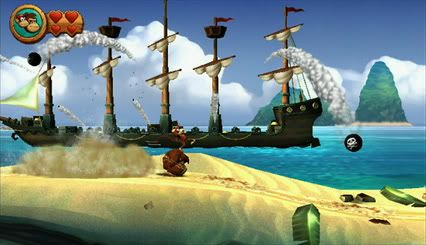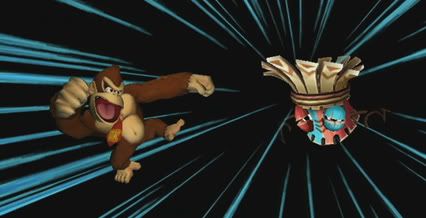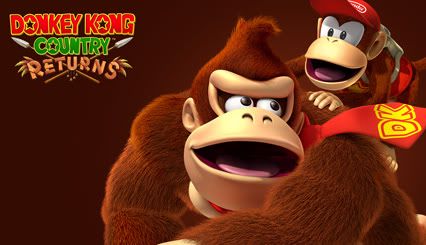- Format: Wii
- Unleashed: Out Now
- Publisher: Nintendo
- Developer: Retro Studios
- Players: 1-2
- Site: donkeykong.nintendo.com/
Never has a Wii game demanded a simple post-release patch quite like Donkey Kong Country Returns. It’s quite impressive actually – one tiny flaw turns an otherwise joyfully creative game into a bit of a chore. The culprit? Motion controls.
DKC Returns controls, for the most part, how you’d expect a 2D nostalgia trip to control. The d-pad moves Kong, there’s a button for jumping, and another for grabbing barrels and running. Simple enough – but that’s only half of the game’s controls. The rest are combinations of d-pad directions while shaking the Wii remote.
Shaking alone makes Donkey Kong slap and shake the ground, revealing hidden areas and items. Ducking and shaking makes him blow wind, also used in accessing secrets. But the biggest culprit is the series’ iconic roll move, done by shaking the Wii remote while running.
 None of these moves are required to finish the game (except in a few, non-annoying spots), but you’d miss out on most of the secrets – and the roll makes an otherwise lumbering Donkey Kong incredible agile. Even when you get the hang of it, it’s an unpleasant motion that can get really tiring if you’re taking advantage of it. That, and it’s unreliable – sometimes you won’t get the shake just right and you’ll walk off of a ledge instead.
None of these moves are required to finish the game (except in a few, non-annoying spots), but you’d miss out on most of the secrets – and the roll makes an otherwise lumbering Donkey Kong incredible agile. Even when you get the hang of it, it’s an unpleasant motion that can get really tiring if you’re taking advantage of it. That, and it’s unreliable – sometimes you won’t get the shake just right and you’ll walk off of a ledge instead.
We’re harping on it because from the very beginning of the game, straight through to the final boss, the shaking controls were a constant nagging issue. If they’d just offered a control scheme that let you play without it, the game would be damn near perfect.
And that’s the rub, it’s a single bad design decision (albeit a prevalent one), in a game that otherwise offers pixel-precise controls, beautiful levels gushing with creativity, and a welcome challenge.
DKC Returns is a nearly perfect nostalgia trip – it nails the formula of the SNES games for the most part, but still manages to have its own identity. There are new gameplay twists at every corner, and vibrant level design that often had us grinning ear-to-ear.
 It’s also hard – like, “I lost 20 lives at that last checkpoint” hard. But thanks to extremely precise controls (as long as you’re not rolling) and level design that pushes you to react without forcing rote memorisation, the challenge is rarely frustrating.
It’s also hard – like, “I lost 20 lives at that last checkpoint” hard. But thanks to extremely precise controls (as long as you’re not rolling) and level design that pushes you to react without forcing rote memorisation, the challenge is rarely frustrating.
Even if the game gets the best of you, it’s willing to make concessions in the name of fun. Items in Cranky Kong’s shop can be used to make Donkey Kong nearly invincible, and Nintendo’s Super Guide (introduced in New Super Mario Bros. Wii) returns to give you a free pass on any levels that defeat you.
The upside to all this challenge is the satisfaction it brings. Donkey Kong Country is one of the best arguments for challenge in modern gaming this side of Super Meat Boy. There’s a thrill to nailing a long string of strictly timed platforming bits and coming out on the other side unscathed. Even if you fail a few times, the distance between checkpoints will push you to master the tough spots, making you all the more skilled for the challenges ahead.
 Some people will scoff at the slightest frustrations, calling DKC Returns a game built on memorisation rather than skill, but they’d be wrong. The game rewards skillful platforming and punishes those that don’t stay on their toes, but it’s never forcing you to memorise long sections. Even levels where you’re barrelling along on a mine cart or rocket, the game gives you ample opportunity to react. It’s clear that developer Retro’s intent was to walk the line between exhilarating challenge and frustration, and on nearly every level they succeed brilliantly.
Some people will scoff at the slightest frustrations, calling DKC Returns a game built on memorisation rather than skill, but they’d be wrong. The game rewards skillful platforming and punishes those that don’t stay on their toes, but it’s never forcing you to memorise long sections. Even levels where you’re barrelling along on a mine cart or rocket, the game gives you ample opportunity to react. It’s clear that developer Retro’s intent was to walk the line between exhilarating challenge and frustration, and on nearly every level they succeed brilliantly.
There’s a good amount of meat to this game to boot. Those that aim for 100% completion won’t be disappointed with the wealth of secrets to be had. While platformers get a lot of heat for mindless collecting, DKC succeeds by putting most of the vital collectibles in clever hiding places. The only problem is that the more time you spend searching for secrets, the more you have to deal with the frustrating controller shaking motions. Many of the secrets are revealed by pounding the ground, blowing out torches, spinning fans, and occasionally using the roll move to extend the length of your jumps.
Still, getting past the annoyance, there’s so much vibrant level design in Donkey Kong Country Returns. Whether you’re running through a sunset casting a silhouette of Kong and Diddy in the foreground, plowing through walls atop a rhino, or blasting from barrel to barrel like a cannon ball, there’s a kinetic energy to the game that’s hard to deny. There are surprises at every turn, such as one level where some innocent looking eggs explode into a torrent of baby spiders that you must outrun.
With this revival, Retro Studios has breathed new life into a classic SNES series, and crafted one of the best platformers on the Wii. Assuming you’re up for the challenge, it’s a damn near perfect game. That said, the motion controls are such a huge thorn in the game’s side that it never truly reaches the greatness it should. Donkey Kong Country Returns, as fantastic a game as it often is, is also a lesson in how carefully developers must integrate motion controls as they become a bigger part of the game design vocabulary.














Comments